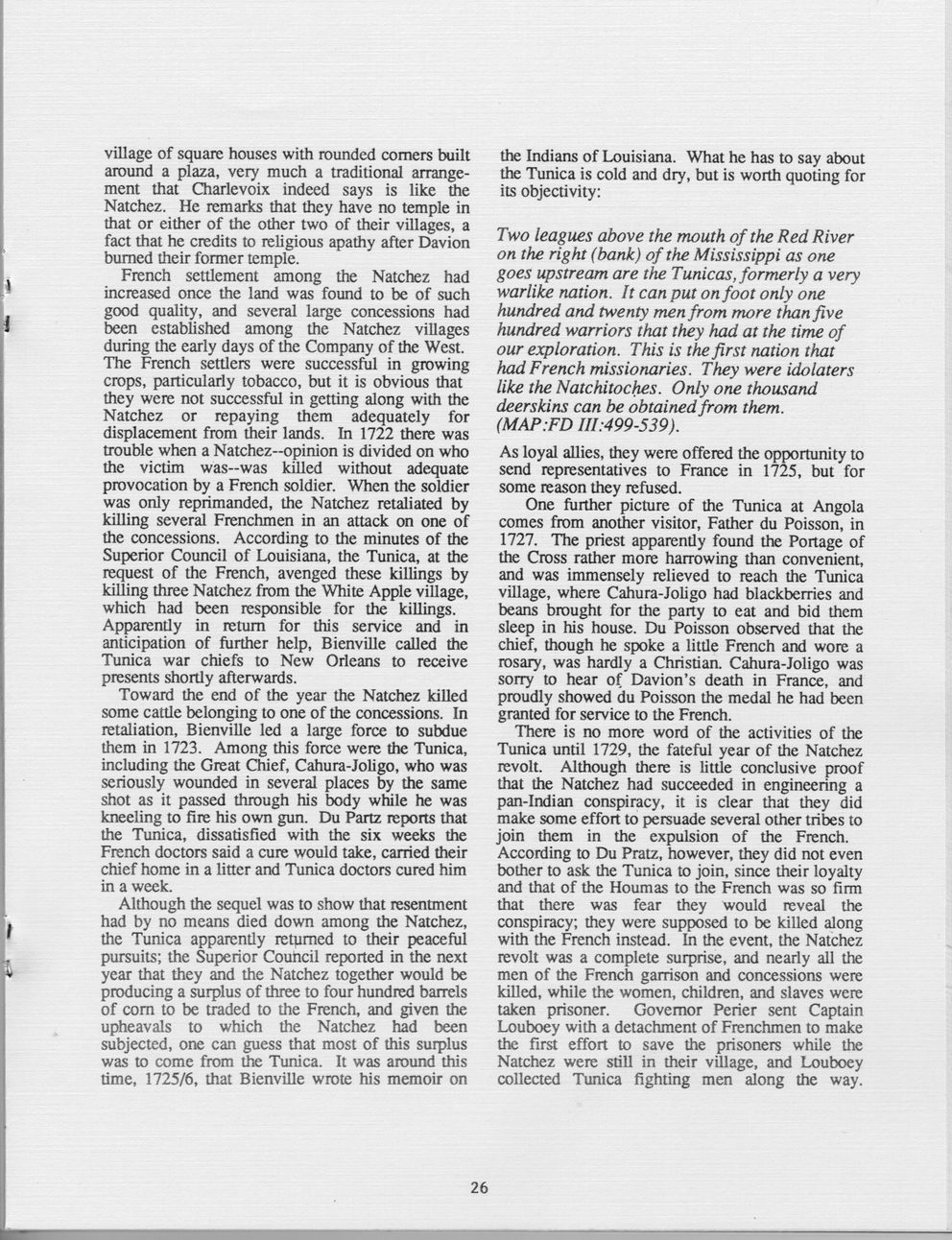This text was obtained via automated optical character recognition.
It has not been edited and may therefore contain several errors.
village of square houses with rounded comers built around a plaza, very much a traditional arrangement that Charlevoix indeed says is like the Natchez. He remarks that they have no temple in that or either of the other two of their villages, a fact that he credits to religious apathy after Davion burned their former temple. French settlement among the Natchez had increased once the land was found to be of such good quality, and several large concessions had been established among the Natchez villages during the early days of the Company of the West. The French settlers were successful in growing crops, particularly tobacco, but it is obvious that they were not successful in getting along with the Natchez or repaying them adequately for displacement from their lands. In 1722 there was trouble when a Natchez-opinion is divided on who the victim was—was killed without adequate provocation by a French soldier. When the soldier was only reprimanded, the Natchez retaliated by killing several Frenchmen in an attack on one of the concessions. According to the minutes of the Superior Council of Louisiana, the Tunica, at the request of the French, avenged these killings by killing three Natchez from the White Apple village, which had been responsible for the killings. Apparently in return for this service and in anticipation of further help, Bienville called the Tunica war chiefs to New Orleans to receive presents shortly afterwards. Toward the end of the year the Natchez killed some cattle belonging to one of the concessions. In retaliation, Bienville led a large force to subdue them in 1723. Among this force were the Tunica, including the Great Chief, Cahura-Joligo, who was seriously wounded in several places by the same shot as it passed through his body while he was kneeling to fire his own gun. Du Partz reports that the Tunica, dissatisfied with the six weeks the French doctors said a cure would take, carried their chief home in a litter and Tunica doctors cured him in a week. Although the sequel was to show that resentment had by no means died down among the Natchez, the Tunica apparently returned to their peaceful pursuits; the Superior Council reported in the next year that they and the Natchez together would be producing a surplus of three to four hundred barrels of com to be traded to the French, and given the upheavals to which the Natchez had been subjected, one can guess that most of this surplus was to come from the Tunica. It was around this time, 1725/6, that Bienville wrote his memoir on the Indians of Louisiana. What he has to say about the Tunica is cold and dry, but is worth quoting for its objectivity: Two leagues above the mouth of the Red River on the right (bank) of the Mississippi as one goes upstream are the Tunicas, formerly a very warlike nation. It can put on foot only one hundred and twenty men from more than five hundred warriors that they had at the time of our exploration. This is the first nation that had French missionaries. They were idolaters like the Natchitoches. Only one thousand deerskins can be obtained from them. (MAP.FD 111:499-539). As loyal allies, they were offered the opportunity to send representatives to France in 1725, but for some reason they refused. One further picture of the Tunica at Angola comes from another visitor, Father du Poisson, in 1727. The priest apparently found the Portage of the Cross rather more harrowing than convenient, and was immensely relieved to reach the Tunica village, where Cahura-Joligo had blackberries and beans brought for the party to eat and bid them sleep in his house. Du Poisson observed that the chief, though he spoke a little French and wore a rosary, was hardly a Christian. Cahura-Joligo was sorry to hear of Davion’s death in France, and proudly showed du Poisson the medal he had been granted for service to the French. There is no more word of the activities of the Tunica until 1729, the fateful year of the Natchez revolt. Although there is little conclusive proof that the Natchez had succeeded in engineering a pan-Indian conspiracy, it is clear that they did make some effort to persuade several other tribes to join them in the expulsion of the French. According to Du Pratz, however, they did not even bother to ask the Tunica to join, since their loyalty and that of the Houmas to the French was so firm that there was fear they would reveal the conspiracy; they were supposed to be killed along with the French instead. In the event, the Natchez revolt was a complete surprise, and nearly all the men of the French garrison and concessions were killed, while the women, children, and slaves were taken prisoner. Governor Perier sent Captain Louboey with a detachment of Frenchmen to make the first effort to save the prisoners while the Natchez were still in their village, and Louboey collected Tunica fighting men along the way. 26

Native Americans The-Tunica-Biloxi-Tribe-its-Culture-and-People-(34)